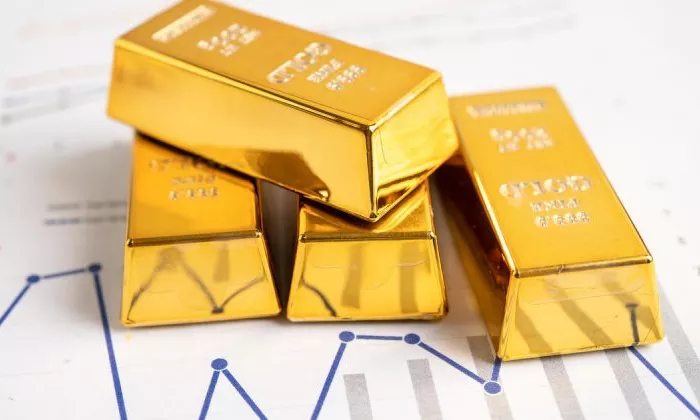Gold prices experienced a notable decline on Monday, November 11, 2024, dropping nearly 1% in the domestic futures market as the US dollar held firm. As of 11:40 am, MCX Gold for the December 5 expiry traded at ₹76,714 per 10 grams, reflecting a 0.72% decrease. This dip follows a week of lackluster movement for gold, with market participants closely monitoring upcoming US macroeconomic data and commentary from Federal Reserve officials for signs of direction in interest rate policies.
On the global front, gold prices also saw a second consecutive session of losses, continuing a downward trend that began after the US presidential elections. The metal is currently lacking fresh catalysts, and the broader market sentiment remains influenced by various uncertainties surrounding both the US economic outlook and geopolitical developments. The US Federal Reserve’s monetary policies, coupled with the impact of Donald Trump’s victory in the 2024 election, have left traders uncertain about the future trajectory of interest rates, inflation, and global economic conditions.
Trump’s return to the White House has reignited concerns that his administration may implement policies that could fuel inflation, potentially delaying the pace of interest rate cuts by the Fed. Experts have pointed out that the prospect of higher tariffs and economic protectionism under Trump’s leadership could lead to an environment of elevated interest rates. This speculation has added to volatility in financial markets and weighed on gold, which is traditionally viewed as a safe haven during periods of inflation and economic uncertainty.
Last week, gold recorded its worst weekly performance in more than five months. This decline coincided with growing concerns that Trump’s economic policies could lead to more aggressive monetary tightening, further elevating interest rates and dampening the appeal of non-yielding assets like gold. Gold’s drop was exacerbated by a stronger US dollar, which traditionally puts downward pressure on precious metals by making them more expensive for holders of other currencies.
Experts Weigh In on Gold’s Short-Term Outlook
As gold continues to experience downward pressure, several market experts have weighed in on the near-term outlook and advised on key levels to watch. Rahul Kalantri, Vice President of Commodities at Mehta Equities, emphasized that the decline in gold and silver prices was largely driven by a rebound in the dollar index. Additionally, US consumer sentiment surged to a better-than-expected 73, further compounding downward pressure on gold. The stronger dollar has been one of the primary forces behind gold’s struggles in recent weeks, as it makes the metal less attractive to investors in other currencies.
Kalantri also pointed to China’s decision to pause its gold purchases for six months, effective from October, as another factor contributing to the decline. According to official data released last week, this pause in Chinese gold purchases has added a layer of uncertainty to the global gold market. Combined with the uncertainty triggered by Donald Trump’s victory, these factors have led market participants to book profits on their long positions in gold and silver, contributing to the metal’s retreat.
Looking ahead, Kalantri noted that the release of US inflation data this week could provide crucial insights into the future direction of the bullion markets. While the immediate outlook for gold remains volatile, Kalantri believes the long-term trend for both gold and silver remains positive. He sees gold holding support at the $2,650–2,634 levels, with resistance at $2,682–2,698. On the domestic front, Kalantri sees gold’s support levels in INR terms at ₹77,020–76,750, while resistance lies between ₹77,480–77,710. For silver, support is expected between $31.00–30.80, with resistance at $31.45–31.65.
Manoj Kumar Jain, a senior analyst at Prithvifinmart Commodity Research, shared a similar view, pointing out that gold is currently trading near its critical support level of $2,692. Jain noted that if gold slips below this level, further weakness could be seen in the coming sessions. However, he remains bullish on the long-term trend for both gold and silver. He highlighted that gold has support at $2,680–2,664, with resistance at $2,716–2,734 per troy ounce. Silver, according to Jain, has support at $31.10–30.80, with resistance between $31.74–32.05 per troy ounce.
For traders in the Indian market, Jain suggested a strategy of selling gold on any price rises to ₹77,600, with a stop loss at ₹77,880 and a target of ₹77,000. He further pointed out that on the MCX, gold’s support is seen at ₹77,000–76,620, with resistance at ₹77,500–77,750. Silver’s support levels are between ₹90,450–89,600, while resistance is expected at ₹91,850–92,600.
Key Factors to Monitor
While the outlook for gold remains uncertain in the short term, experts are advising traders to closely monitor key economic data, including the upcoming US inflation figures. Additionally, developments regarding Donald Trump’s economic policies, especially those related to tariffs, interest rates, and inflation, will be crucial in shaping the price action in gold over the coming weeks.
Geopolitical developments and any significant shifts in global financial markets will also be important factors to watch, as these could cause sudden spikes or drops in gold prices. Despite the near-term volatility, analysts maintain that gold and silver’s longer-term potential remains strong, particularly if inflationary pressures continue to build globally.
As market conditions evolve, traders are urged to stay agile, keeping an eye on technical levels, macroeconomic indicators, and geopolitical risks. The gold market may experience increased volatility in the lead-up to the next Federal Reserve meeting, which could provide further clarity on the central bank’s stance on interest rates and inflation.
Conclusion
while gold is facing downward pressure due to a strengthening US dollar and uncertainties surrounding Trump’s policies, the long-term trend for the precious metal remains bullish. Traders are advised to watch for key support and resistance levels and adjust their strategies accordingly, taking into account the latest economic and geopolitical developments.
Related topics:
- Asia Gold Festivities Boost Demand in India, But Volumes Lag
- Gold Prices Drop Rs 2,500 Per Tola in Pakistan
- Gold Prices Decline from Record Highs in India on November 1


